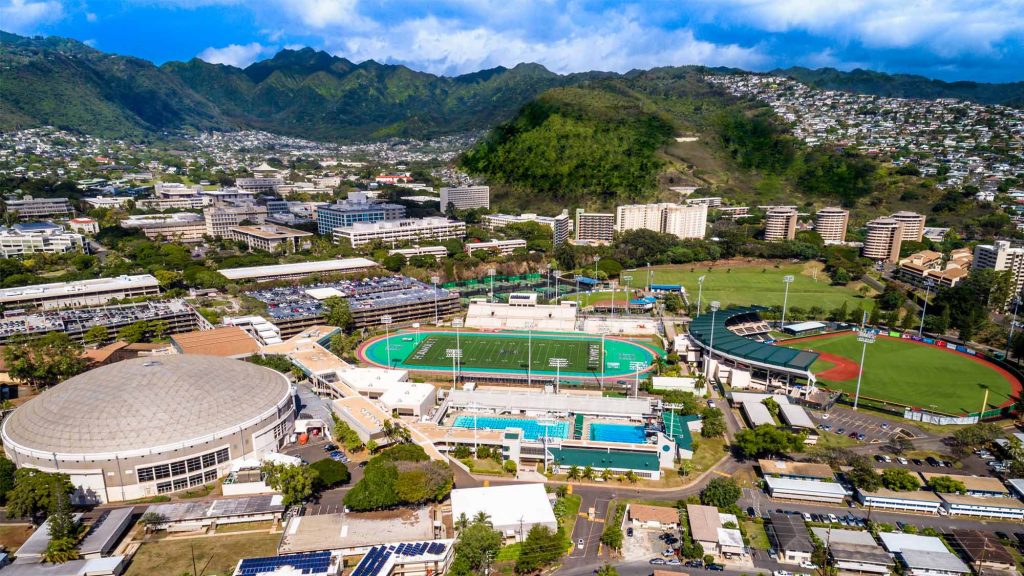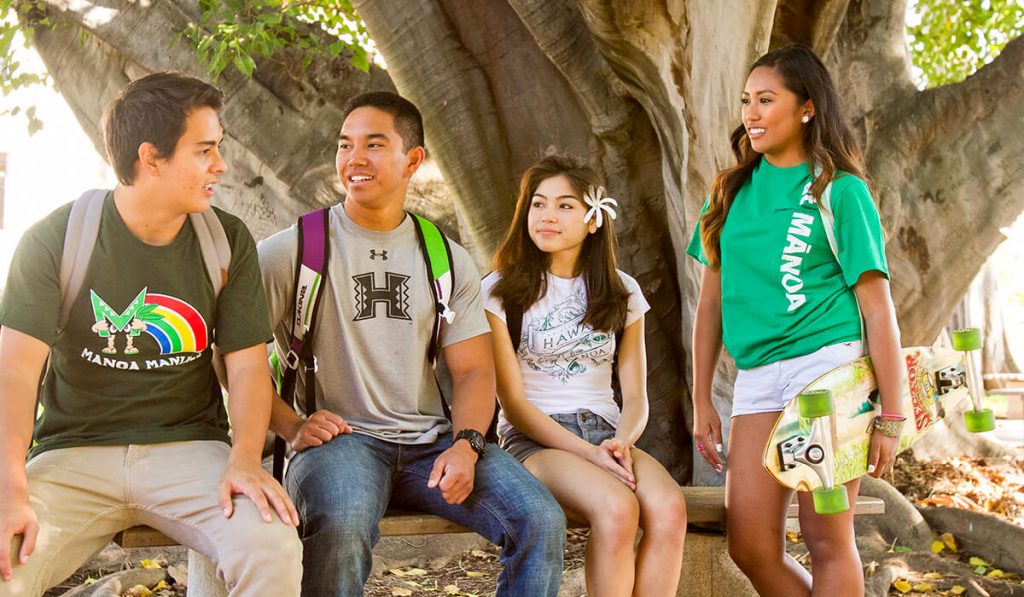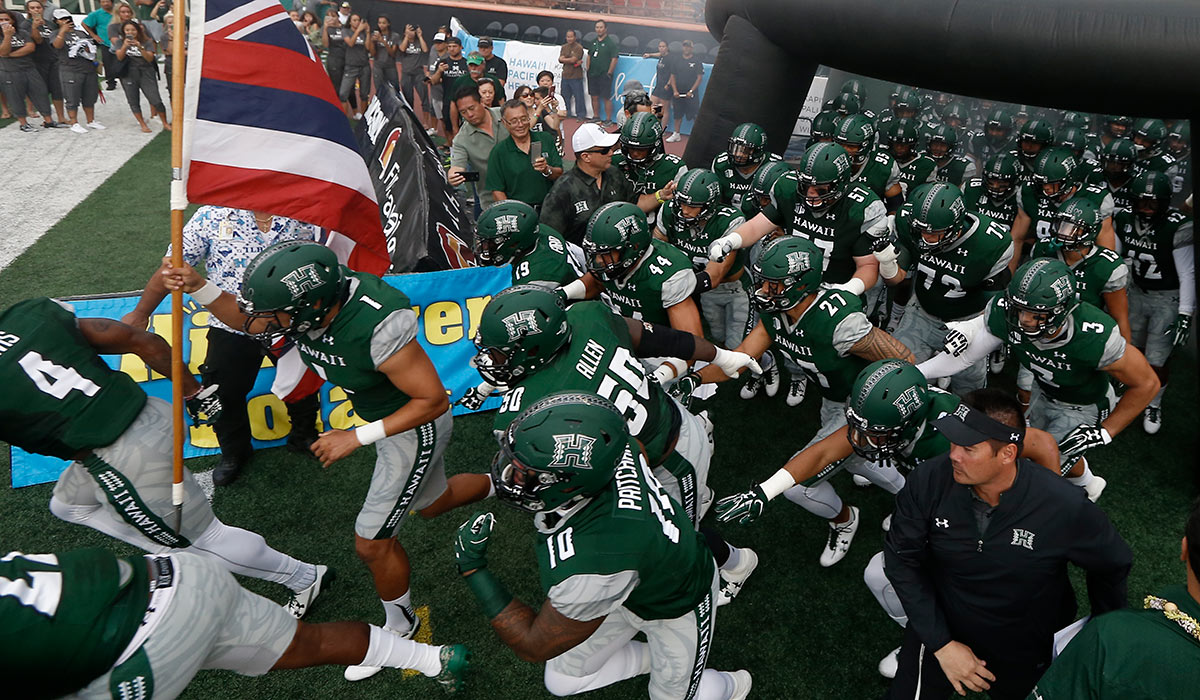Established in 1907, the University of Hawaiʻi at Mānoa is the largest and oldest of the 10 UH campuses. Mānoa offers hundreds of undergraduate, graduate and professional degrees; a strong, vital research program; and nationally ranked NCAA Division I athletics. UH Mānoa is a research university of international standings.
It has widely recognized strengths in tropical agriculture, tropical medicine, oceanography, astronomy, electrical engineering, volcanology, evolutionary biology, comparative philosophy, comparative religion, Hawaiian studies, Pacific Islands studies, Asian studies and Pacific and Asian regional public health.

The University of Hawaiʻi at Mānoa is a world-class university providing affordable, quality higher education to the people of Hawaiʻi and conducting pioneering research to address critical issues facing the state.
Excellent Value
UH Mānoa continues to be an excellent value with tuition more than $4,000 below the national average for a public university, according to the U.S. Department of Education, and one of the reasons why Hawaiʻi, compared to the other states, has one of the country’s lowest rates of student debt. The flagship campus of the UH System is consistently ranked in the top 2 percent nationally and internationally.
Strong Research
UH Mānoa is one of 146 R1: Research Universities, considered the top tier in the country, and one of a handful of land-, sea-, space-, and sun-grant institutions. It is a global leader in earth and environmental sciences, consistently ranked among the top 15 universities internationally, ahead of some of the world’s most prestigious schools. UH Mānoa researchers provide world class expertise to local leaders on important issues including sustainability, climate, food systems and Hawai‘i’s unique health issues.
Multicultural Global Experience
Committed to being the leading indigenous serving university in the country, UH Mānoa proudly delivers a unique multicultural global experience in a Hawaiian place of learning, with a long history of adherence to the principles of sustainability and the essence of aloha—truly like nowhere else on earth.
See our fast facts or, for more detailed information about the University, please visit the Mānoa Institutional Research Office (MIRO) pages.
At a Glance
- Founded: 1907
- Location: beautiful Mānoa Valley, just outside downtown Honolulu, Hawaiʻi on the island of Oʻahu
- Campus size: 320 acres
- University of Hawaiʻi System motto: Maluna aʻe o nā lāhui a pau ke ola ke kanaka (Above all nations is humanity)
Students*
- Total student population: 20,028
- Undergraduate: 15,375
- Graduate: 4,653
- Hawaiʻi (in-state) students: 59%
- Out-of-state / U.S. National students: 35%
- International students: 6%
- States represented: 50
- Countries and Regions represented: 122
- Male/female ratio: 41:59
- Average High School GPA: 3.69
- 51% in the top 25% in High School
*current as of Fall 2024
Undergraduate Student Diversity*

- Asian: 33.6%
- Caucasian: 26.5%
- Native Hawaiian or other Pacific Islander: 16.6%
- Multiracial: 16.6%
- Hispanic: 1.6%
- Black or African American: 2.0%
- American Indian or Alaska Native: 0.7%
*current as of Fall 2024
Financial
Undergraduate
The Office of the Registrar’s site has a complete breakdown of the latest Undergraduate Tuition and Fee charges at the University of Hawaiʻi at Mānoa. This includes the undergraduate charges for resident, non-resident, Western Undergraduate Exchange (WUE), Pacific Island Jurisdiction, and Compacts of Free Association (COFA) students.
Graduate
The Office of the Registrar’s site has a complete breakdown of the latest Graduate Tuition and Fee charges at the University of Hawaiʻi at Mānoa. This includes the undergraduate charges for resident, non-resident, and Compacts of Free Association (COFA) students.
Cost of Attendance
To assist students and their families in planning ahead for matriculation from the University of Hawaiʻi at Mānoa, the Financial Aid Services office has provided estimates of the costs that a typical student might incur in their Cost of Attendance budgets.
Academics
- Colleges and Schools: 14
- Degrees (programs and academic areas)
- Bachelor’s degrees: 93
- Master’s degrees: 84
- Professional and Doctoral degrees: 54
- Accreditation: Accrediting Commission for Senior Colleges and Universities of the Western Association of Schools and Colleges (WASC)
- UH Mānoa is consistently ranked among the top 2% of nearly 24,000 universities in the world
- Five UH Mānoa subjects are in the top 75 in the world according to the 2024 Global Ranking of Academic Subjects (GRAS). These include oceanography (#7); atmospheric sciences (#13); hospitality and tourism management (#32); earth sciences, geography, ecology, political sciences, and communication (ranging from #51–200).
Research
One of only a handful of universities nationwide to hold the distinction of being a land-, sea-, and space-grant institution, UH Mānoa is ranked in the top 60 public universities in research expenditures by the National Science Foundation.
The University of Hawaiʻi at Mānoa maintains a vibrant and active research program with more than $464.9 million in new extramural funds for research in 2024. UH Mānoa’s faculty includes members of the National Academy of Sciences, the National Academy of Engineering and the National Institute of Medicine.
Classified by the Carnegie Foundation as having “very high research activity,” UH Mānoa is known for its pioneering research in such fields as oceanography, astronomy, Pacific Islands and Asian area studies, linguistics, cancer research, and genetics.
Lyon Arboretum is the only research facility in the U.S. located in a tropical rainforest, and is home to over 5,000 species of tropical and sub-tropical plants.
The UH Translational Health Science Simulation Center is regarded as one of the most advanced simulation centers in the nation, and gives students a chance to experience real-life scenarios using high-tech simulation technology.
Athletics

- Member of the Mountain West Conference, Big West Conference, Mountain Pacific Sports Federation, Pacific Coast Intercollegiate Yacht Racing Association Intramural, recreational, and outdoor sports.
- NCAA Division I athletics program with approximately 450 student athletes competing on 21 men’s, women’s and co-ed varsity teams.
- Men’s Sports: Baseball, Basketball, Football, Golf, Swimming & Diving, Tennis, Volleyball
- Women’s Sports: Basketball, Cross Country, Golf, Sailing, Sand Volleyball, Soccer, Softball, Swimming & Diving, Tennis, Track & Field, Volleyball, Water Polo
- Co-Ed Sports: Cheerleading, Sailing
Campus Life
- Student organizations: over 135
- Intramural sports: varies by semester
- 18% of undergraduates live on-campus (10 residential halls and 2 apartment complexes).
Special Academic Opportunities
- Combined Bachelors and Masters (BAM) Degree Pathways
- Honors Program
- ʻImi Hoʻōla Post-Baccalaureate Program
- International Research
- National Student Exchange
- Study Abroad & Mānoa International Exchange
- Student Internships & Cooperative Education
- Undergraduate Research Opportunities Program
Alumni
More than 170,000 alumni reside in 50 states and more than 100 countries worldwide. Below are just a few of UH Mānoa’s many notable graduates who are leaders in their field:
- Neil Abercrombie, MA ’64, PhD ’74, former Governor of Hawaiʻi
- Robyn Ah Mow-Santos, ’96, USA Volleyball Team member and former Olympian
- Daniel Akaka, BEd ’52, MEd ’66, U.S. Senator (retired)
- Arsenio Balisacan, PhD, ’85, Socioeconomic Planning Secretary and Director-General of the National Economic and Development Authority of the Philippines
- Angela Perez Baraquio, BEd ’99, MEd ’04, Miss America 2001
- Michael Chun, MS ’68, president, Kamehameha Schools
- Tammy Duckworth, BA ’90, U.S. Congresswoman former Assistant Secretary of Veterans Affairs
- Colleen Hanabusa, BA ’73, MA ’75, JD ’77, former U.S. Congresswoman
- Mazie Hirono, BA ’70, U.S. Senator
- David Ige, BS ’79, MBA ’85, Governor of Hawaiʻi
- Daniel Inouye, BA ’50, U.S. Senator
- Jong-wook Lee, MPH ’81, former Director-General of the World Health Organization
- Edward Tsang Lu, postdoctoral fellow, former NASA Astronaut
- Sabrina McKenna, BA ’78, JD ’82, Hawaiʻi Supreme Court Associate Justice
- Patsy Mink, BA ’48, former U.S. Congresswoman
- Kenneth P. Moritsugu, BA ’67, former Surgeon General
- Ken Niumatalolo, BA ’90, U.S. Naval Academy head football coach
- Barack Obama Sr., BA ’62, Father of U.S. President Barack Obama
- Richard D. Parsons, BA ’68, former Chairman of Citigroup
- Cheryl Castro Petti, BA ’94, CNN Radio network anchor
- Patricia Saiki, BS ’52, former member of the U.S. House of Representatives and teacher
- Ann Dunham Soetoro, PhD ’92, mother of U.S. President Barack Obama
- Jay Shidler, BBA ’68, entrepreneur and benefactor of the Shidler College of Business
- Mark Takai, BA ’90, MPH ’93, U.S. Congressman
- Charles Nainoa Thompson, BA ’86, navigator and former trustee of Kamehameha Schools
Rankings
See the Mānoa Institutional Research Office (MIRO) for domestic and international ranking information about the University.
